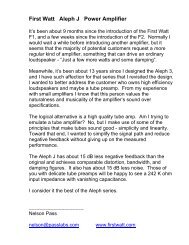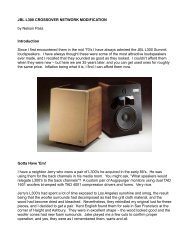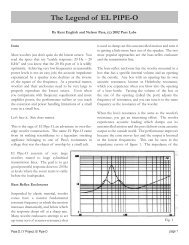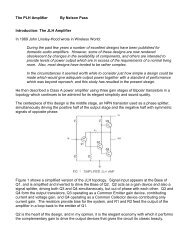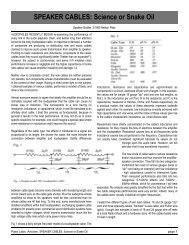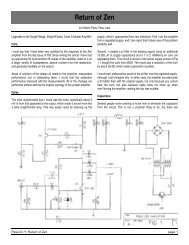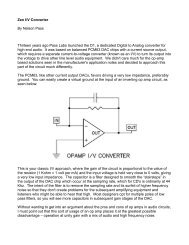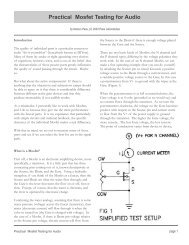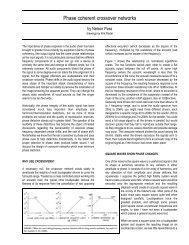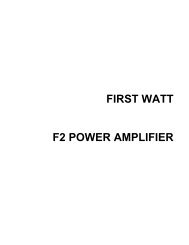Burning Amp part 2 - First Watt
Burning Amp part 2 - First Watt
Burning Amp part 2 - First Watt
- No tags were found...
You also want an ePaper? Increase the reach of your titles
YUMPU automatically turns print PDFs into web optimized ePapers that Google loves.
<strong>Burning</strong> <strong>Amp</strong> 2by Nelson PassIntroductionIn <strong>Burning</strong> <strong>Amp</strong> 1 we examined an amplifier circuit designed to complement the hardware wegave away to some attendees at last October's <strong>Burning</strong> <strong>Amp</strong> Festival in the San Franciscobay area. This first design centered on a power output stage having of four banks of parallelN channel Mosfets. It was a single-ended Class A amplifier which delivered high qualitysound with only local feedback.<strong>Burning</strong> <strong>Amp</strong> 2 will use virtually the same front end and power supply but coupled tocomplementary banks of N and P channel power Mosfets used as followers in a push-pullClass A configuration.There is an advantage to the push-pull Class A output stage over the single-ended outputstage of the BA-1 as it can be operated more efficiently and delivers much higher outputcurrent into load impedances below 8 ohms.ConceptAs with BA-1, this amplifier has a voltage gain stage which uses matched P channel Jfets todifferentially accept a balanced or single-ended input signal. Following the Jfets, an Nchannel Mosfet provides single-ended voltage amplification controlled by a local loop. Theoutput stage is a push-pull Class A power follower, biased by a TL431 monolithic shuntvoltage regulator.
The component numbers here will correspond to those in later, more detailed schematics.We see the JFET input differential pair Q201 biased by current source Q202, the voltage gaintransistor Q203, the output bias voltage source Q13 and the output power followers Q1 andQ2. Local feedback for the front end comes through R204. R201 equals R202, R203 equalsR204 and the gain of the balanced front end is set by the ratio of R204 / R202. P201 is avariable resistor which adjusts the DC offset of the front end, and Q203 drives a bootstrappedsource formed by R208, R209, and C208.Power SupplyHere is the basic schematic of the power supply. This is essentially identical to many of thepower supplies found in earlier articles such as the Zen series and the <strong>First</strong> <strong>Watt</strong> amplifiers.The components are fairly ordinary. As the typical <strong>Burning</strong> <strong>Amp</strong> will dissipate maybe 300watts, the transformer wants to be rated at least twice that. The diode bridge is 35 amps at200+ volts, and you can use ordinary or fancy high-speed bridges as you please. There werea variety of transformers given away with these chassis, and our goal is to haveapproximately +/- 25 volts on the supply rails. Voltages from 18 to 30 volts are acceptable,and for transformers with secondaries much higher than 20 volts AC, operation using theprimary taps in series as shown may reduce the secondary voltages to the desired levels.
C1 and C2 are line-rated types only, as they will be filtering AC line voltages. ThermistorsTH1 through TH3 are high power types such as Keystone CL60. TH1 and TH2 are used tosuppress inrush surges on turn-on, and also are useful at reducing mechanical noise in thetransformers in conditions of high line noise. You will see that the chassis of the amp is to bedirectly attached to the AC Earth, and TH3 is used to attach analog ground to the chassisthrough the resistance of TH3, reducing issues with ground loops.C3 through C6 are your standard high capacity power supply capacitors. The “long” <strong>Burning</strong><strong>Amp</strong> chassis with parallel output devices “6 deep” accommodates four such capacitors, the“shorter” chassis holds two. I recommend that the owners of the “short” chassis to find a wayto mount two more capacitors at the front of the amp for C3 and C4. You will also note 10 uFfilm capacitors across the supply lines. You can delete these, remembering that the prototypeused them.All the resistors in the supply are 3 watt or higher types, and you can see R1 through R8 usedto form an RC filter to reduce the supply ripple on the second set of capacitors.From a layout standpoint, you can wire the supply just as you see on the schematic. The twocrucial things to remember is that the ground point labeled STAR is the one you want to bringthe signal grounds back to. The other issue is to keep the signal wiring at some physicaldistance from the transformer, AC lines, and the rectifier bridge and the wires attached to it.Output StageBecause this output stage is intended for more than one project, a modular approach is beingtaken, and we will consider the output stage by itself. Here is the schematic of the “6 deep”output stage. The “4 deep” output stage is achieved by deleting two pairs of output devices
and the associated resistors. All the <strong>part</strong>s are also numbered between 101 and 199.The 1 ohm resistors are all 3 watt types, and the output devices are best matched for (the)Vgs within about 0.1 volts or so at 500 mA or so. It is not necessary or practical to match theN channel <strong>part</strong>s to the P channel <strong>part</strong>s. P101 is used to set the bias current of the outputstage, and P102 is used to adjust the output DC offset.Meet the New Front End. (Same as the Old Front End)As with the output stage, the front end needs good stand-alone qualities. Besidesaccommodating single-ended and balanced inputs, we want a range of potential voltage gainfigures, the ability to swing the output stage close to the rails, and performance that will notsignificantly degrade the stand-alone performance of the output stage. Most amplifiersenclose the output stage in the feedback loop with the front end, but that will not be the casehere. This is largely the same as BA-1 with the removal of all the output stage biasingelements:
All the <strong>part</strong>s are numbered in the range of 201 to 299. This front end circuit is different fromBA-1 in that it does not include the <strong>part</strong>s to bias the output stage – those have been shifted tothe output stage schematic to make these projects more modular in the future. It also deletesC204, the capacitor from the output of the front end to ground, as it happens that the outputstage of BA-2 has more input capacitance than that of BA-1, providing a more optimal amountfor a clean square wave response. I have also lowered the gain, although you can put it backin if you like.Q201 is a dual matched pair of P channel Jfets, <strong>part</strong> 2SJ109. These are in scarce supply(although the recipients of <strong>Burning</strong> <strong>Amp</strong>s will each get a pair). They can be substituted withmatched 2SJ74 types, and a number of other <strong>part</strong>s will function with lesser performance.Q201 is biased by a constant current source formed by Q202 and R205. Q202, an N channelJFET 2SK170 with Idss of about 10 mA, is operated as a constant current source by simplyattaching the Gate pin to the Source pin. If you don't have a 2SK170 with the 10 mA Idss, youcan parallel two lesser Idss <strong>part</strong>s. The 10 mA figure is not critical, and potentiometer P201provides flexibility on the value. R205 takes up some of the dissipation that would otherwisebe found in Q202, keeping it within dissipation spec. As shown on the schematic, you willtypically see about 10 volts across this <strong>part</strong>, reflecting the 10 mA current.R201 through 204 form the balanced inputs networks. R201 = R202 and R203 = R204, andthe gain is R204/R202. Compensation capacitors C201 and C202 form the high frequencyroll-off for the gain, and while C201 is not strictly essential, it helps to retain the balanced inputcommon mode rejection figure at high frequencies.
When operating the amplifier with a single-ended (RCA) input, the negative input is shorted toground. You can use dual input connectors, RCA and XLR with the hot RCA connected to pin2 (+) of the XLR and RCA ground to pin 1. Pin 3 is the (-) input, and can be shorted to pin 1on the XLR for single-ended input.The output signal from the input JFET appears across P201 and drives the Gate of MosfetQ203 which provides the remainder of the voltage gain for the front end. P201 providesadjustment against the expected variations of components in the front end and is used to setthe output DC figure of the front end only. No “lag” frequency compensation is employed.The Drain of the Mosfet Q203 is biased with about 15 mA of current provided by the series 3watt resistor values of R208 and R209. On the Source of Q203 the gain is degenerated byR207 at 100 ohms, limiting the gain and improving the linearity and bandwidth of this stage.The point between R208 and R209 is “bootstrapped” from the output of the amplifier throughC208. In many designs a constant current source would be employed here, but this approachis simpler.You will note that RC networks appear between the output node of the front end and the inputof the output stage. C203 rolls off the low frequency response at about 2 Hz and I chose touse a 10 uF polypropylene type here, as the only capacitor in the signal path. You couldconsider using an Elna 10 F silk electrolytic here, in which case you want to orient the +polarity pointed to the left, toward the R215.R210, R211, C205 and C206 form a supply decoupling filter which helps keep the noise lowby filtering the ripple from the raw power supply rails.Construction NotesAll the usual comments about construction apply to this amplifier. The parallel output devicesshould be matched for Vgs so that they share current well, and of course we note that allMosfets are static sensitive until installed in the circuit, so they should be handled withreasonable care. Once in the circuit they are protected by D101 and D102.Heat sinking for this amplifier is vital, and should be enough that the metal on which thetransistors are mounted is at 65 deg C or less, and the fins should be at 55 deg C or less. Ifthey are higher, you need to consider ventilation, fans, and/or lower bias current. The diodebridge for the power supply should also be mounted on metal for heat sinking, and Q203 isbest provided with some sort of “push-on-tab” heat sink.The power transformer should be rated at 600 VA or more. Two channels of this amp will maydraw as much as 300 watts, and we allow at least a 2 to 1 transformer margin.Safety first: Use the smallest value Slow-Blow type fuse that holds up under continuousoperation. Start with a 3A value and increase to 4 or 5A if necessary.More Safety first: The chassis must be solidly grounded to the AC earth ground and should
e attached to the analog circuit ground either directly, or through power thermistors or diodebridges if it is necessary to prevent ground loop noise issues.Initial Turn-on and AdjustmentsWhen the amplifier is first fired up, it is best done without a load. At a minimum you will needa DC multimeter so as to separately adjust the DC offset figures of the front end and theoutput stage.The most important things to do before applying power to the circuit are to set thepotentiometers to “safe” settings. This means that P201 and P102 should be set at their“middle” positions, and that P101 should be set for maximum resistance. You can use amultimeter to confirm that P101 is at maximum – at one extreme you will measure 0 ohms orso across the potentiometer, and at the other extreme several K ohms. Set it at the maximumresistance extreme.It is very useful to apply power using a Variac to raise the AC power voltage while checkingthe current draw of the circuit. It is important to monitor the voltage across the 1 ohm Sourceresistors of the output devices for current, and also to check across R210 and R211 forexcessive voltage. It's best to initially do this with one channel connected to the power supplyat a time, and it's also best to do this at low AC power voltages, rechecking at increasedvoltage.When you get to the point where full power is applied and there is low current draw by theoutput stage, that is a good sign. Set P201 to adjust the Drain voltage of Q203 toapproximately 0 volts. This value is not critical, as it is isolated from the output in any case.Then you want to adjust the DC output of the amplifier using P102, again setting it to about 0volts. You will be adjusting it again later, after you bias the output stage.Use multimeter to confirm the various voltages which are shown in the schematics to confirmthat they are nominally close to those values. You will want to keep an eye on the amplifier asit warms up, and you will end up re-adjusting the values of the potentiometers.The amplifier prototype I built biased the output stage at 250 mA per output device, whichmeasures as 250 mV across each of the 1 ohm Source resistors on the output stage. You willwant to gently adjust P101 to this figure while watching the voltage across one of the 1 ohmresistors. When you reach that figure, use the multimeter to confirm a close value across allthe 1 ohm output stage resistors.This figure will wander upwards as the output stage warms up, but it should stabilize nicely atsome higher value. Watch this carefully and periodically readjust P101 to maintain the 250mV bias figure until it stabilizes. Come back later and be prepared to adjust it again.The bias current figure is not set in stone. If you have lots of heat sink, feel free to set thebias at a higher figure. The 250 mA setting results in dissipation of about 6 watts pertransistor for the output stage shown. If you have lots of heat sinking, you could considertwice as much bias, for 3 amps of bias per channel. This would be about 300 watts perchassis, The maximum this power supply and chassis could ever be expected to work with.
The decision comes down to heat. Heat sinks should stabilize at a temperature at which youcan put your hand on the heat sinks fins for about 5 seconds. This is between 50 and 55 degC, and is the ideal figure. As mentioned before, you should consider better ventilation or lessbias if the heat is much greater.You have other options as well. You can choose to use fewer devices than the output stageshown here. For example, if you chose to use 3 pairs of power Mosfets instead of 6, youcould double the bias on each one for 12 watts with the same overall dissipation. Rememberthat the 6 pairs in this design simply reflected what was in the chassis given away at <strong>Burning</strong><strong>Amp</strong>. Some other units had 4 pairs of devices per channel.For fewer output pairs, consider using proportionally lower values of Source resistors on thepower Mosfets. For example, with 2 pairs, 0.33 ohm might be a better choice than 1 ohm.Unlike the single-ended output stage of BA-1, the push-pull output stage in BA-2 can bebiased at lower current values and still achieve the same maximum output power. Of courseit will do so by falling into Class B (also thought of as AB), but this certainly is preferred toclipping.In any case, you have a great deal of flexibility with regards to power and bias with this outputstage that you do not have with a single-ended Class A circuit, where the maximum peakoutput current is the same value as the bias current.It could be argued that the single-ended Class A is more sonically pure. If all you want to dois drive 8 ohms or greater, than that might be the case.PerformanceLike the BA-1, the measured performance of both stages together is comparable to that ofjust the follower output stage. Here is the distortion vs power at 1 Khz into 8 ohms:Here is the distortion vs. power at 1 Khz into 4 ohms:
Here is the distortion vs. power at 1 Khz into 2 ohms:Clearly the BA-2 has far more capacity into low impedance loads than BA-1.Here is the amplifier frequency response curve at 1 watt:
And here is the distortion vs. frequency:This figure deserves some discussion, as it illustrates the notorious “IR P channel problem” inwhich the transconductance of the International Rectifier P channel Mosfets exhibit a shelvingin the midband. For complementary followers, this shows up as increased second harmonicabout about 200 Hz, leveling off around 1 Khz. Is this really a problem? Perhaps it is if youjudge by specs, but I have not heard actual complaints from listeners, probably becausesecond harmonic is relatively inoffensive. Here is what the distortion waveform looks like:There are three common cures to this:Use different P channel Mosfets – this problem is specific to IR P channel <strong>part</strong>s.Place the output stage in a feedback loop to correct it.Use these circuits in balanced output stages, where the second harmonic will cancel.Correcting this issue with one or more of the above will reduce the mid to high frequencydistortion by about half or more, depending on which cures you pick.Or you can say, “My, that lovely second harmonic certainly warms up the midrange on coldwinter nights.”Under “miscellaneous”, the measured damping factor of the amplifier came in at about 50 (an
output impedance of 0.16 ohms). The noise was about 100 uV at the output, and thebalanced input Common Mode Rejection Ratio (CMRR) was about -50 dB.The SoundThe sonic signature of this sort of circuit is familiar to me after many years of playing withvariations on it. It's noted for a warm characteristic and a slightly soft top end. Both the BA-1and BA-2 have a lineage that goes back to the A75 amplifier from 1992, and they sound a bitlike it.The BA-1 is a little better sonically at low power levels, but is not as capable of being scaledto higher power levels or driving low impedance loads. By contrast the BA-2 can be biased atlower levels if necessary, and can drive low impedance loads without burping. The BA-2 is alittle bit softer at the top, and the BA-1 has a tad more detail at the top.Both sound very good, and if you spend enough time with them, the warmth and soft top endmight tend to spoil you for other solid state pieces, so if you have a lot of money invested inthe L word, or the K word, or the H word, maybe it's best not to know.The BA VariationsBefore publication, I have received several requests for clarification and expansion:It's obvious that for the follower designs we can create a front end independent of the mainamplifier. As the quarters are tight in the BA chassis, this is a good idea, as it will allowplacement away from the noisy power supply and give us considerable flexibility in switchingout different circuits without having to take the amp a<strong>part</strong>. As I said, most of the BA designswill be followers without feedback, so you should feel free to go this route. Variac refers tothese as BAGS. I forget why.The gain of this front end is set at about X 6, or 15 dB. You can have higher gain simply bychanging R203 and R204 to higher values. You can double the gain (to about 20 dB) byincreasing these to 100 Kohm, and you can push it to 150 Kohm (about 23 dB) withoutchanging the compensation capacitors.Any more and we might have to apply for a THX sticker. *You can certainly build this amplifier with fewer output devices as mentioned earlier. It willalter the spectral balance slightly – more outputs tends to put a little more emphasis on thebottom end, and fewer tends to brighten the top. At least this is how you will tend to perceiveit. I leave it to you to try this if you like, but I think the direction you would want to go is 2-3pairs, as we already have overkill with 4.I have shown a recommended value for the output stage bias at 250 mA / device which is onlyabout 6 watts per device with a +/-25 volt supply. If you have enough heat sinking, you canconsider as high as 30 watts per device, allowing the reliable use of fewer devices.
If you decide to higher, remember that Mosfets are better at higher current until they catch fireand fulfill the promise of the amplifier's name.The supply voltage range is limited by the voltage ratings of the front end Jfets. 35 volts isabout as far as you dare go, and 30 volts is the recommended maximum. Any more and youwill have to cascode the P channel devices (not so difficult) and increase the value of R205 to15 or 20 Kohms, otherwise it should work fine.Less than 18 volts is really not recommended as it starts taking too much out of the circuit'sperformance (in my humble opinion).Regulating the supply is a perfectly good idea, and will lower the noise figure slightly. Irecommend some nice big capacitors to ground after the regulators to help avoid interactionbetween the amplifier and regulator circuits.And yes, there are capacitors in the circuit. One is even employed to form the dreadedbootstrap on the voltage gain stage.Get over it. **As always, you are invited to share your experiences at www.diyaudio.com.* that's a joke - I say that's a joke, son...** Not a joke.© Nelson Pass 2009



